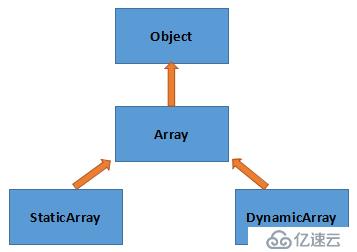C++中支持原生数组,但由于原生数组的天然缺陷(不能获取长度信息、越界访问不会报错...),我们有必要来开发自己的数组类,从而解决这些问题。
数组类的继承关系如图:
需求分析:
1、由于线性表,不能作为数组直接使用,我们需要自己实现一个数组类来代替原生数组。
2、解决原生数组越界访问不会报错的问题
3、提供数组的长度信息
template < typename T >
class Array : public Object
{
protected:
T *m_array;
public:
T& operator [] (int index)
T operator [] (int index) const
bool get(int index, const T& e)
bool set(int index, const T& e)
virtual int length(void) = 0;
};template < typename T >
class Array : public Object
{
protected:
T *m_array;
public:
T& operator [] (int index)
{
if( (index>=0) && (index<length()) )
{
return m_array[index];
}
else
{
THROW_EXCEPTION(IndexOutOfBoundsException, "array index out of range...");
}
}
T operator [] (int index) const
{
return const_cast<Array<T>&>(*this)[index];
}
bool get(int index, const T& e)
{
bool ret = (index>=0) && (index<length());
if( ret )
{
e = m_array[index];
}
return ret;
}
bool set(int index, const T& e)
{
bool ret = (index>=0) && (index<length);
if( ret )
{
m_array[index] = e;
}
return ret;
}
virtual int length(void) = 0;
};设计要点:
template < typename T, int N >
class StaticArray : public Array<T>
protected:
T m_space[N];
public:
StaticArray()
// 提供拷贝构造喊赋值重载函数,实现数组的拷贝
StaticArray(const StaticArray<T, N>& obj)
T& operator = (const StaticArray<T, N>& obj)
int length(void)
};template <typename T, int N>
class StaticArray : public Array<T>
{
protected:
T m_space[N];
public:
StaticArray()
{
this->m_array = m_space;
}
StaticArray(const StaticArray<T, N>& obj)
{
this->m_array = m_space;
for(int i=0; i<length();i++) // 数组元素拷贝
{
m_space[i] = obj.m_space[i];
}
}
T& operator ==(const StaticArray<T, N>& obj)
{
if(this != &obj)
{
this->m_array = m_space;
for(int i=0; i<length();i++)
{
m_space[i] = obj.m_space[i];
}
}
}
int length(void)
{
return N;
}
};
设计要点:类模板
template < typename T >
class DynamicArray : public Array<T>
{
protected:
int m_length;
public:
DynamicArray(int length)
DynamicArray(const DynamicArray<T>& obj)
DynamicArray<T>& operator = (const DynamicArray<T>& obj)
void resize(int length)
~DynamicArray()
};DynamicArray类中的函数实现存在重复的逻辑,可以进行代码优化。
重复代码逻辑的抽象:
— init 函数中实现对象构造时的初始化操作
— copy 函数负责从堆空间中申请内存,并执行拷贝构造操作
— updata 将指定的堆空间作为内部存储数组使用
template <typename T>
class DynamicList : public SeqList<T>
{
protected:
int m_capacity;
public:
DynamicList(int capacity)
{
this->m_array = new T[capacity];
if(this->m_array != NULL)
{
this->m_length = 0;
this->m_capacity = capacity;
}
else
{
THROW_EXCEPTION(NoEnoughMemoryException,"No memory to create DynamicList object ...");
}
}
int capacity()const
{
return m_capacity;
}
void resize(int capacity)
{
if(capacity != m_capacity)
{
T* array = new T[capacity];
if(array != NULL)
{
int length = (this->m_length < capacity ? this->m_length : capacity);
for(int i=0;i<length;i++)
{
array[i] = this->m_array[i];
}
T* temp = this->m_array;
this->m_array = array;
this->m_length = length;
this->m_capacity = capacity;
delete[] temp;
}
else
{
THROW_EXCEPTION(NoEnoughMemoryException,"No memory to create DynamicList object ...");
}
}
}
~DynamicList()
{
delete[] this->m_array;
}
};
总结:
免责声明:本站发布的内容(图片、视频和文字)以原创、转载和分享为主,文章观点不代表本网站立场,如果涉及侵权请联系站长邮箱:is@yisu.com进行举报,并提供相关证据,一经查实,将立刻删除涉嫌侵权内容。